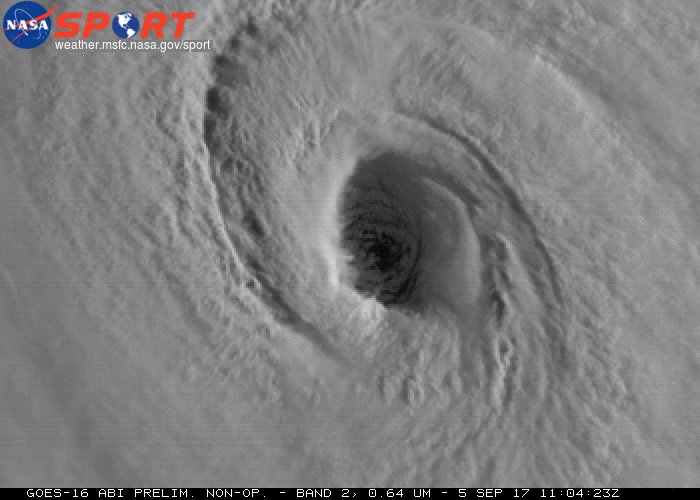Hurricane Irma made landfall in the Caribbean on Wednesday with record winds and powerful waves.
The Category 5 storm – the strongest Atlantic hurricane ever recorded north of the Caribbean and east of the Gulf of Mexico – passed over the island of Barbuda overnight.
The National Hurricane Center has warned of a growing possibility the hurricane could slam Florida later this week – as Texas and Louisiana are still dealing with the devastating aftermath caused by Hurricane Harvey.
“Everyone in hurricane-prone areas should ensure that they have their hurricane plan in place,” officials have said.
Here’s what you should know about Hurricane Irma and its trajectory.
Where is Hurricane Irma today?
As of Wednesday afternoon, Hurricane Irma is approximately 90 miles east of San Juan, Puerto Rico, according to a 2 p.m. ET National Hurricane Center advisory.
It has maximum sustained winds of about 185 mph, the advisory said.
When is it expected to make landfall?
Hurricane Irma hit through Barbuda early Wednesday morning – knocking out phone lines and breaking down communication between islands as the eye of the storm passed. Midcie Francis of the National Office of Disaster Services confirmed there was damage to several homes, but said it was too early to assess the extent.
Antiguan police are waiting until winds dropped down before sending helicopters to check on reports of damage in Barbuda. There were no immediate reports of casualties.
The island of Anguilla was experiencing “extremely heavy winds and rain,” according to the Disaster Management Department. There have been reports of flooding, but specific details are not yet available.
FLORIDA DECLARES STATE OF EMERGENCY AHEAD OF HURRICANE IRMA
Additionally, Turks and Caicos, the Bahamas, Cuba, the Dominican Republic and Haiti are also in the projected path of Hurricane Irma, according to the National Hurricane Center.
President Donald Trump has already declared emergencies in Florida, Puerto Rico and the U.S. Virgin Islands, and authorities in the Bahamas said they would evacuate six southern islands.
What else should I know about the storm?
Hurricane Irma is classified as a Category 5 storm – meaning it is extremely dangerous. It brings with it life-threatening winds, storm surges and rainfall, according to the National Hurricane Center.
Authorities warned that the storm could dump rain, cause landslides and flash floods and generate waves. Government officials began evacuations and urged people to finalize all preparations as shelves emptied out across islands including Puerto Rico.
HURRICANE IRMA NOW POWERFUL CATEGORY 5 STORM
“The decisions that we make in the next couple of hours can make the difference between life and death,” Puerto Rico Gov. Ricardo Rossello said. “This is an extremely dangerous storm.”
“It also has the potential to significantly strain FEMA and other governmental resources occurring so quickly on the heels of (Hurricane) Harvey.”
Residents on the U.S. East Coast were urged to monitor the storm’s progress in case it should turn northward toward Florida, Georgia or the Carolinas.
“This hurricane has the potential to be a major event for the East Coast. It also has the potential to significantly strain FEMA and other governmental resources occurring so quickly on the heels of (Hurricane) Harvey,” Evan Myers, chief operating officer of AccuWeather, said in a statement.
And while its impact on the continental U.S. isn’t fully known yet, it is almost certain to hit the country by early next week. Florida Gov. Rick Scott already declared a state of emergency Monday in all 67 counties in order to ensure “local governments have ample time, resources and flexibility to get prepared for this dangerous storm.”
“In Florida, we always prepare for the worst and hope for the best and while the exact path of Irma is not absolutely known at this time, we cannot afford to not be prepared,” Scott said.
Officials in the Florida Keys geared up to get tourists and residents out of Irma’s path, and the mayor of Miami-Dade County said people should be prepared to evacuate Miami Beach and most coastal areas.
South Carolina’s Gov. Henry McMaster also declared a state of emergency in the Palmetto state on Wednesday ahead of the storm.
The last Category 5 storm to hit the United States was Hurricane Andrew in 1992. An estimated 250,000 were left homeless and the storm caused more than $20 billion in damage in the Bahamas, Florida and Louisiana. Fifty-five people were killed.
Also Wednesday morning, a new tropical storm formed in the Gulf of Mexico off Mexico’s coast. Tropical Storm Katia has maximum sustained winds of 40 mph with some strengthening forecast over the next two days.



